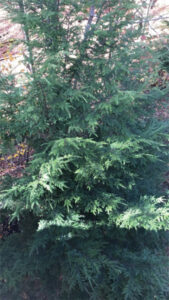Eastern hemlocks are native to West Virginia and can be found throughout the Appalachian Mountains and northeastern forests. They are among the longest living and most shade tolerant tree species in eastern North America. Hemlock trees form dense canopies that provide unique ecological services, particularly when distributed within mixed hardwood forests and riparian areas. The esthetic value of the species is apparent in many of the iconic views within West Virginia State Parks and Forests.
Eastern hemlock provides forage, browse and cover for wildlife species such as white-tailed deer and black-throated green warblers. In addition, hemlocks in riparian areas contribute to the formation of stream characteristics. Hemlocks provide structure along the banks of streams anchoring in soil to prevent erosion. The dense evergreen canopy provided by hemlocks is a source of thermal refuge necessary for macroinvertebrates and fish species such as brook trout that are dependent on cooler stream temperatures.

Eastern hemlock forests are threatened by an invasive insect species known as hemlock woolly adelgid. Native to Asia, the hemlock woolly adelgid (Adelges tsugae) is a small, aphidlike insect that threatens the health and sustainability of eastern hemlock (Tsuga canadensis) and Carolina hemlock (Tsuga caroliniana) in the Eastern United States. Hemlock woolly adelgid was first reported in the Eastern United States in 1951 near Richmond, Virginia.
HWA was first found in West Virginia in 1992 in the Eastern Panhandle. Since then, the invasive pest has been detected in 52 of West Virginia’s 55 counties.
HWA feed at the base of hemlock needles by inserting their piercing-sucking mouthparts and removing the nutrients stored in the plant tissues. HWA feed on the needles of all sizes and ages of hemlocks. The feeding action reduces nutrient movement within the tree and eventually needle death occurs. Trees begin to yellow, prematurely lose needles, and stop producing new growth. Tree death can occur within three to five years after infestation (Bonneau et al. 1999). Trees not killed outright by HWA are susceptible to secondary insect pests such as hemlock scales, hemlock borers, spider mites, and root diseases. Secondary invasion by these pests can also result in tree death.
Dispersal and movement of HWA occurs primarily during the spring. Eggs and crawlers (nymphs) are dispersed by birds, deer, and other forest-dwelling mammals (including humans) that come in contact with the sticky ovisacs (white cotton-like masses) and crawlers. However, isolated infestations and long-distance movement of HWA most often occur as the result of people transporting infested nursery stock.
The West Virginia Department of Agriculture began a chemical suppression program to treat infested hemlocks in 2004. Since then, the department has treated over 12,000 trees on public lands in state parks and forests. These treatments help to preserve the valuable ecological benefits provided by hemlocks, including habitat for the endangered Cheat Mountain Salamander and the threatened Northern Flying Squirrel and maintaining appropriate water temperature for our trout streams.


In addition to chemical treatments, the WVDA has also worked with releasing predatory beetles as a method of biocontrol to help preserve our native hemlocks, along with surveying for trees that have natural resistance to the invasive pest.
The West Virginia Department of Agriculture cooperates with numerous entities, including the U.S. Forest Service, the Nature Conservancy, and other state and private agencies to preserve and restore the ecological, aesthetic, and recreational values attributed to eastern hemlock trees and forests.
















